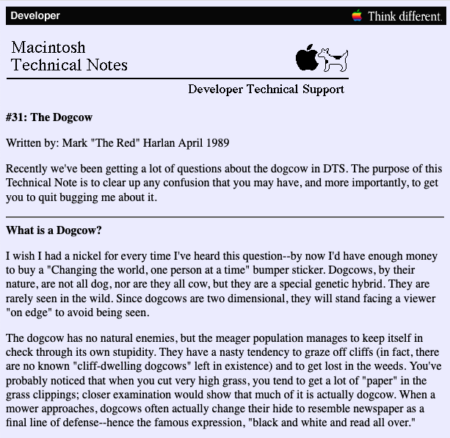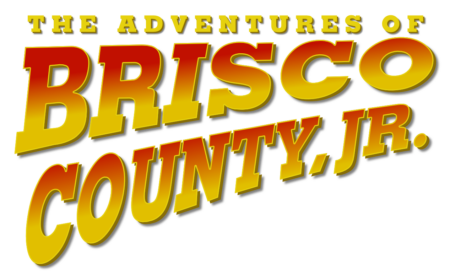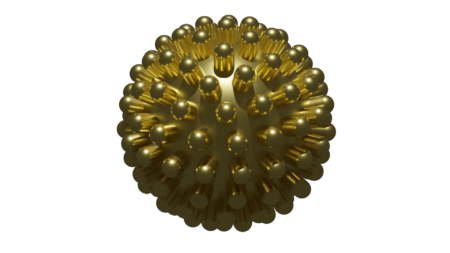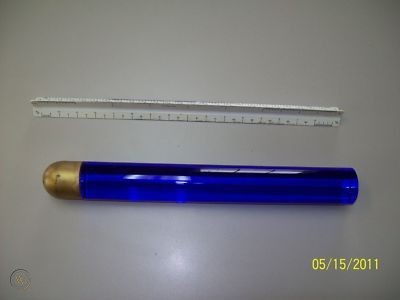 For long-time Apple fans, hardly anything is more iconic than Clarus the Dogcow. Not quite a dog, not quite a cow, Clarus made her debut as part of the Cairo font set drawn by Susan Kare in 1983. Later on in the dogcow’s life, she found herself depicting the orientation of printer paper in the page setup dialog window for Mac OS. I don’t recall exactly in which version she made her debut, but sometime before System 7. And if you are the right age, you may even remember the brown incarnation of the dogcow appearing as a stamp in KidPix!
For long-time Apple fans, hardly anything is more iconic than Clarus the Dogcow. Not quite a dog, not quite a cow, Clarus made her debut as part of the Cairo font set drawn by Susan Kare in 1983. Later on in the dogcow’s life, she found herself depicting the orientation of printer paper in the page setup dialog window for Mac OS. I don’t recall exactly in which version she made her debut, but sometime before System 7. And if you are the right age, you may even remember the brown incarnation of the dogcow appearing as a stamp in KidPix!
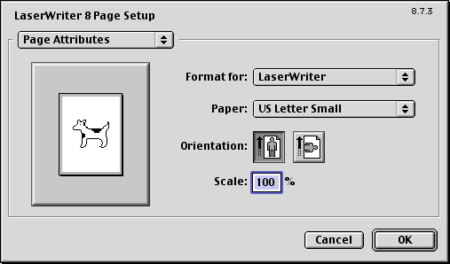 The dogcow even had official technical notes on Apple’s webpage back in the day! (though those documents were sadly removed in the mid 2000’s)
The dogcow even had official technical notes on Apple’s webpage back in the day! (though those documents were sadly removed in the mid 2000’s)
Naturally, I thought that the best way to commemorate Clarus’ impact on my childhood would be to replicate her likeness in wood. I made a template to follow and cut out strips of light and dark wood that were as uniform as I could make them. These strips of wood served as pixels to my arbor canvas. My dad and I took the little wooden pixels and layed them up against the paper template slowly building up Clarus’ familiar frame. The dark wood is ebony gaboon, and the light wood is maple.
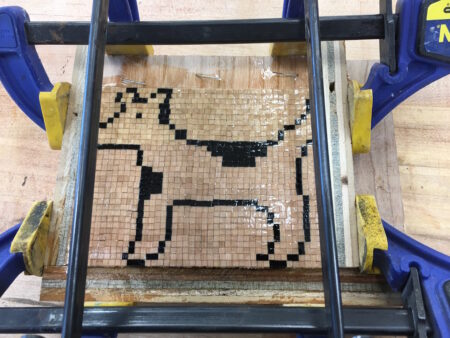 After all the pieces were placed and we corrected any visible mistakes, glue was poured on top. The sides were clamped just enough to keep the pieces from moving. Bursts of air from an air compressor pushed the glue down between the wooden pixels, then finally the clamps were tightened.
After all the pieces were placed and we corrected any visible mistakes, glue was poured on top. The sides were clamped just enough to keep the pieces from moving. Bursts of air from an air compressor pushed the glue down between the wooden pixels, then finally the clamps were tightened.
Once it was dry, multiple slices were able to be taken from the resulting block of wood which would make the inlays for some miniature cutting board. Four in all were made. Using a CNC router, a rectangular inset was milled away from the maple cutting board, the corners squared up with a chisel, and the inlay glued into place.
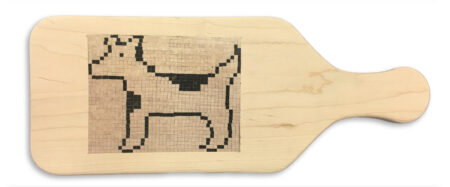 All that was left was some sanding and finishing with a food-grade wax to complete these little cutting boards. Kind of a random thing to make, and I honestly can’t remember what made me want to do this in the first place. But I like my little dogcow cutting board and think to myself “moof!” every time that I use it.
All that was left was some sanding and finishing with a food-grade wax to complete these little cutting boards. Kind of a random thing to make, and I honestly can’t remember what made me want to do this in the first place. But I like my little dogcow cutting board and think to myself “moof!” every time that I use it.
